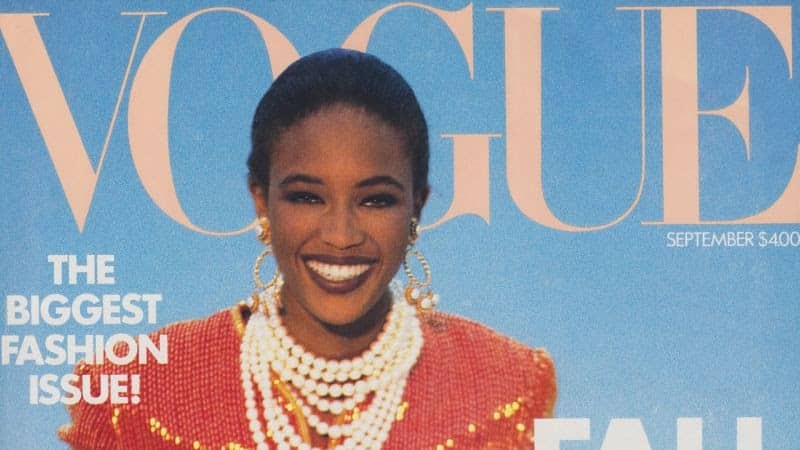
Vogue is the largest and most famous fashion magazine around the globe and has adapted to the times. The Vogue logo is truly legendary, one that lets the font do the talking and makes itself memorable. First published in 1892, the magazine has grown and is now distributed in 23 countries and has around 11 million subscribers. Although the magazine and the logo may have both changed over time, that doesn’t mean that they haven’t kept some iconic elements.
The logo has stayed with the familiar and iconic font that is at the heart of the logo. The magazine as well has kept elements that make it memorable and familiar. Let’s take a look at what is at the heart of the logo and magazine that has stayed the same throughout time.
1890s: The Start
When Vogue first launched in 1892 their inscription was limited to only one font. Vogue has first launched a weekly title for New York high society and due to the limitations with their typeface, the magazine opted to have each nameplate feature a handwritten logo created by their designer. Each issue’s logo complimented the issue and the cover and its style.
1900s: A Change
Almost two decades later and the magazine decided it was time to change a few things with the magazine covers. By 1909 they had decided to make the cover art more colorful, portrayed in the jazz era, or imitate the art deco direction. This was at a point when the magazine’s target audience was changing, so they thought it was only fitting that the magazine design is specific to the new target audience and cater to them. Vogue hired first-class illustrators that worked to create poster-like images for the magazine covers.
1920s – 1930s: The First Photographic Cover
Throughout this period, the magazine’s hand-drawn logos contained to remain. At the to,e hand-drawn logos were very popular, so Vogue was trending and considered current for the logos they were using. In 1932 Vogue produced its first color photographic cover that was shot by Edward Steichen. Accompanying the cover was a logo showing a minimalistic and simple set of white letters. In 1933 the logo was being experimented with by designers, the logo styles being new and unique every time.
1940s: Varied Styles
The Didot font made an appearance in 1947, but it was in a condensed and simpler version. At this point the designers were still going back and forth with the typefaces, jumping between a few different options with every logo that was put forth. They were trying out new logo options, sometimes mixing in photographic letters, sometimes using serif, and sometimes using sans-serif. The magazine was undecided on what was the best option for the covers and they kept experimenting with different typeface options.
1950s: A More Permanent Option
By 1955 Vogue had decided on using at least a semi-permanent option for their covers. The all uppercase Didot font found its permanent home as a logo on Vogue’s magazines. The logo is very simple, only using the magazine name in the font that stands out on the covers. This logo is merely a wordmark, boldly expressing the magazine and the company that’s behind it.
What Makes The Vogue Logo Iconic?
Although it certainly has had its fair share of changes throughout its time, that doesn’t mean the publication’s logo hasn’t become an iconic part of it. We think that the only true answer to this is to put the credit to the font. After all, when you use a wordmark as your logo it’s only natural that the font is what’s given the most attention to. Vogue understood that the logo had to be legendary since it was representing the brand and was what would be displayed on the cover of magazines.
When we think about why this logo works so well for publication and why it’s become so famous, it’s due to the font. The font is what proudly displays the magazine’s name and uses sleek letters to show the magazine’s personality and to establish a brand. The logo is everything that the magazine itself is; sleek, stylish, and impressionable. The logo shows class and style, giving it all the characteristics that help it to stand out and become a signature part of the magazine.
The History Of Vogue

Vogue has a history that is almost as eccentric as the history of its logo, starting from the bottom and working itself into one of the most respected and well-known magazines today. The history of Vogue starts in 1892 in America when the magazine was started as a weekly high society journey. It was created by Arthur Baldwin Turnure for New York City’s social elite. The weekly high society journal intended to provide and cover news on social etiquette, the local social scene, and such. The point of the publication was to have a publication that celebrated the “ceremonial side of life”.
This publication targeted the New York upper class and focused on news that would intrigue them. The magazine mainly focused on fashion and social etiquette at the time. Vogue proudly published its first issue on December 17th of 1892. This first issue cost a mere 10 cents, now a price that is considered very meager. In 1909 Vogue was bought by Conde Montrose Nast and a few changes were made to the magazine. Instead of focusing on the local news, the magazine was transformed into a women’s magazine.

The magazine made history by being one of the first magazines that used a color cover on their magazine cover. The magazine was regarded for its high-quality editorial images and the changes that they were making in the fashion industry. They broke out of normal and defied traditions within the industry. Under the watchful eyes of talented editors in chief Vogue presented authoritative content to readers.
Nast focused on hiring only the best photographers and illustrators to present the best content for the magazine. The magazine was making history and in the 1960s they redefined the look of female models. In 1974 Vogue’s cover was the first that featured an African American model.

In 1988 Anna Wintour become Vogue’s Chief Editor. Wintour was not one to follow trends, instead, she believed in shaping fashion trends and making a difference. She changed Vogue covers for the future by emphasizing not only the women’s faces but their bodies as well. Instead of having the magazine covers feature the traditional fashion models, she opted to feature Hollywood actresses on the covers.

Wintour was also the mastermind behind creating Teen Vogue and Men’s Vogue for the magazine. Wintour wanted to reach a wider audience and was working to change the norms and what the traditional fashion magazines looked like. Wintour’s determination and talent were what truly shaped the magazine and brought the magazine high circulation. The staff was finding new and exciting trends that were affordable, branching out to an entirely new audience while still staying relevant.
Wintour was the driving force behind some of Vogue’s most popular and successful editions. The edition that was published in September 2004 was the magazine’s biggest ever monthly publication with a total of 832 pages included. Currently, Anna Wintour is still the editor-in-chief for American Vogue and is known for completing revitalizing a magazine and making history with trends and magazine editions. Wintour is well known for her success with Vogue and for being the driving force behind helping to revive and create the famous publication.
4 Fun Facts About Vogue
Lauren Hutten has appeared on the cover of Vogue a total of 28 times. She’s the queen of Vogue covers, being the model who recorded appearing on Vogue the most times in history.
90 dogs have appeared on Vogue’s cover. There’s even been a few covers that are entirely devoted to dogs and let them be the main focus for the publication.
Madonna was the first-ever female celebrated to be shown in a Vogue magazine. The iconic singer appeared on Vogue’s cover in 1989 when the pop star was only 31 years old and her picture was shown on the front page.
Anna Wintour has been to more than 3,000 fashion shows on behalf of the publication.
Summing Up The History Of The Vogue Logo
As we conclude both the history of Vogue and its iconic logo we can say without a doubt that the publication has earned its way to being the most famous publication in the world. First starting over a decade ago in 1892 the magazine publication has since then grown rapidly and has become arguably the most influential and famous fashion magazine to exist. The magazine has a global audience and is read by 11 million people in the United States and a whopping 12.5 million around the globe.
The one thing that we can be certain of is that the magazine has come leaps and bounds since first starting with its focus on social etiquette, book reviews, and as a focus for high society. Vogue has defied what society views as normal and made trends with fashion, now regarded highly by a wide audience of readers. There’s no denying that fashion magazine has greatly impacted the world of fashion.
When we think about the publication we associate it with the logo that is on each publication cover. Although it may have taken the magazine years before it felt confident with a logo that they felt represented the magazine well, it’s now a recognizable attribute of the publication. Since the logo is merely a wordmark, it relies on the font to do all the work. The font is strong, bold, and represents the fashion magazine remarkably well.








